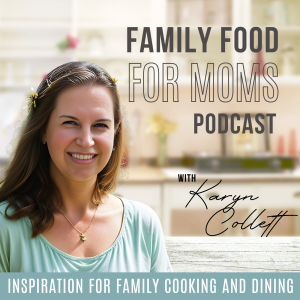Family Food for Moms Podcast I Inspiration for Family Cooking and Dining I How to Enjoy Special Meals Together
Hi friends! I’m Karyn and this is the Family Food for Moms podcast. We’re talking about inspiration for family cooking and dining. Do you ever feel overwhelmed or discouraged as a Mom trying to feed your family healthy meals. Would you like to be inspired in the kitchen. Would you like your mealtimes to be full of joy, fun and healthy delicious food. Come hang out with me on the Family Food Podcast so I can inspire you to bring the purpose and inspiration back into your family meals. We’ll learn about food from our grandmother’s ways of cooking, from other cultures and from ancient traditions. And in the process, we’ll make the family table a special place that you and your children will remember forever. I help Moms feed their families nourishing, delicious food, find purpose in their cooking, learn from past generations and other cultures; and celebrate special meals together through practical advice, tips, inspiration and encouragement.
Episodes

Monday Nov 24, 2025
Monday Nov 24, 2025
Note: This is the last episode for 2025 - I'll see you again in January. Thanks for being part of my community - you are awesome! Happy Thanksgiving and a blessed Christmas to you and your family.
Today, let's talk about crockpots - slow cookers.
A crockpot is one of the most time-saving things, and I'm always surprised at how many people either don't have a crockpot, or they don’t know how to use theirs; they don’t know what to cook in it.
Hopefully, after this episode, you'll know a lot more, and you'll feel confident in using a crockpot.
One of the great things about a crockpot is that they're so cheap to buy. They're one of the cheapest kitchen appliances there is.
https://familyfoodformoms.com/
https://familyfoodformoms.com/product/elegant-easy-appetizers-5-ingredient-recipes-physical-book/

Monday Nov 17, 2025
Monday Nov 17, 2025
Today we’re going to talk about what we can learn from Ireland, the green Emerald Isle, about food and nutrition, cooking and dining. Hopefully you can become inspired and get some good ideas from this episode.
Ireland's food and dining culture has changed a lot over the last few decades. It used to be very simple, hearty fare, and that's the sort of food we’re going to be looking at.
There'll be no Wednesday episode this week - I'll be back next Monday.
Don't forget about our recipe book Elegant Easy Appetisers available here.

Wednesday Nov 12, 2025
Wednesday Nov 12, 2025
Today we're going to be talking about some of my favorite side dishes to cook with a meal. We’ll look at some examples of side dishes, mainly from a few English countries, and maybe a couple of others. Generally they’ll be ones that are familiar, and you just need to be reminded of.
My favorite kind of side dish is steamed vegetables. These are very simple to make. There are green beans, chopped butternut squash or sweet potato, long stem broccoli, and Brussels sprouts. All of those work so well simply being steamed. The cheapest way to do this is to use a steamer tray that’s like an insert. It’s made from stainless steel, and it has holes in it.
Steaming vegetables is one of the healthiest ways to eat them. That way, they retain the most nutrients, and they retain the most flavor because it's not boiled away.

Monday Nov 10, 2025
Monday Nov 10, 2025
Today we're going to talk about what we can learn from India about cooking; dining and good nutrition - from the grandmothers and from the culture. It's really fascinating to see how they go about cooking and the relationship they have with food.
Indian cuisine is very interesting. It's fresh and spicy, made with whole foods as well as medicinal ingredients. Indian cooks cook slowly, paying attention to the order and the process of cooking.
I hope you're feeling inspired to try some Indian recipes!

Wednesday Nov 05, 2025
Wednesday Nov 05, 2025
Today we’re going to be talking about Swiss comfort food. Swiss comfort food is like no other, and Switzerland is so well known for its cheese and its chocolate. In a book by Weston Price, that famous dentist who toured the world, he talks about Swiss people many generations ago who lived on healthy, thick bread and cheese in the mountains, and how healthy their teeth were.
There’s so much about Swiss cheese and European cheese that’s so good for us, and they have amazing comfort foods made from cheese, like Swiss fondue, etc. We're going to talk about some of those. Then chocolate, of course, is a wonderful snack, especially Swiss chocolate. It just tastes the best - it's so good! I love the cute little chocolates that they decorate with Swiss chalets and Swiss snowy mountain scenes. You don't have to cook chocolate, and it's definitely a Swiss comfort food.

Monday Nov 03, 2025
Monday Nov 03, 2025
I want to give you some ideas for lunches and snacks on the go. These are great for if you're a mom that's fetching and carrying your kids to and from school, extra-mural activities, or sports games, or for anytime you want to take food with; sometimes for your kids as well, and sometimes just for you. Sometimes you need something to eat in the car while you wait, or maybe you're just going to be away from home and you'll need to eat.
Even if you're just at home working, sometimes it's better to prepare food the night before, or in the morning, so that when you're hungry and you want to grab something, it's there ready for you to eat. Somehow, if food is prepared in advance, and if we've put a little thought into it, we’re less likely to grab something unhealthy, or something that doesn’t have enough nutrients.
We need to plan carefully to get the right nutrients when we're always busy - like most moms are - or often on the run.

Wednesday Oct 29, 2025
Wednesday Oct 29, 2025
Today we're going to be talking about Italian comfort foods, easy meals that you can make when you need something comforting. So, let's talk about Italian comfort food.
Of course, there’s pizza and pasta. What could be more comforting?
Let's talk about some deas for a quick, easy Italian dish or a comfort food on a cozy full evening, or even on a summer's day, or if you want some good snacks.

Monday Oct 27, 2025
Monday Oct 27, 2025
Today we’re going to be talking about French comfort foods, which are one of my favorite kinds of easy comfort foods. I'm going to do a series with a different cuisine each time. We'll cover Italian comfort food, Mexican comfort food, et cetera, but this one is definitely my favorite because the French just have a way with food.
We'll be talking about Croque Monsieur, French toast, and a few other things that you can make easily, and that'll fill that hungry gap in the winter or anytime you need some comfort food. French comfort foods are things that don’t really need the fancy chef techniques; things that you can make easily. They don't have fancy ingredients, and they don't take a lot of time. They're indulgent, homey, and yummy.
The first one, of course, is croc monsieur or croc madam. There’s a slight difference between the two. Croque monsieur is a warm ham and cheese sandwich that's baked or pan fried with bechamel sauce on top. Croque Madame is the same, just with a fried egg on the top. Often these sandwiches have an authentic cheese like Gruyère or Emmentale to give them that extra edge of flavor. You can add interesting things to the bechamel as well, but the basic croc monsieur is a fabulous comfort food.

Wednesday Oct 22, 2025
Wednesday Oct 22, 2025
Today we are gonna be continuing our Chef's series, talking about Matty Matheson, what we can learn from him and his cooking style, ways that he can inspire us in our own cooking.
I relate well to this one because it's all about being a little bit unorthodox and going with your passion and not necessarily doing things by the book - I like that.

Monday Oct 20, 2025
Monday Oct 20, 2025
Today we're going to be talking about six easy dinner ideas that you can make for dinner in less than an hour when you're stuck, and you're not quite sure what to make.
I'm also going to mention five three-course meal ideas that are easy, but a little fancier. These are good for those days when you want to do something special, but it's still got to be economical and easy. So, here we go. Let's start with the six ideas for when you're stuck for dinner.

About the Family Food for Moms Podcast
Hi friends, I'm Karyn and this is the Family Food for Moms podcast.
Do you ever feel overwhelmed or discouraged as a Mom trying to feed your family healthy meals? Would you love to be inspired in the kitchen. Would you like your mealtimes to be full of joy, fun and healthy delicious food.
Come hang out with me on the Family Food Podcast so I can inspire you to bring the purpose and inspiration back into your family meals. We'll learn about food from our grandmother's ways of cooking, from other cultures and from ancient traditions. And in the process, we'll make the family table a special place that you and your children will remember forever.
We're talking about inspiration for family cooking and dining!
I want to help you with the inspiration, the perspiration, and the celebration of food in your family. So often we only talk about the middle one of these, the perspiration. That's all the practical stuff. We need to plan meals, we need to shop, we need to actually cook the meals, and we need to serve them to our family. And that’s what takes up a lot of the time, but I think there's so much more to food in our families than the perspiration. The first category, inspiration and the third category, celebration are just as important as the practical part, the perspiration.
So on this podcast, we're going to be talking about all three of these things. We need the inspiration. It's the information that we can get from all kinds of places, from our grandmothers or our parents, the way they used to cook and eat, learning from other cultures like the French, the Italian, the Mexican, and the way they do things, the internet and famous cooks and chefs from the past or the present. We should know what we want to achieve and why, and then we should know how we want to go about that.
Celebrating together as a family is such a wonderful thing, especially when it's done with food. Having special family meals that bring connection and closeness. Fun events, traditions, those just help us to enjoy our meals, enjoy our food and to relax after the craziness of life.
We'll talk about all kinds of family events, uh, family, fun nights, date nights at home, larger family celebrations, or just all kinds of things you can do to help to celebrate your dinners together.








